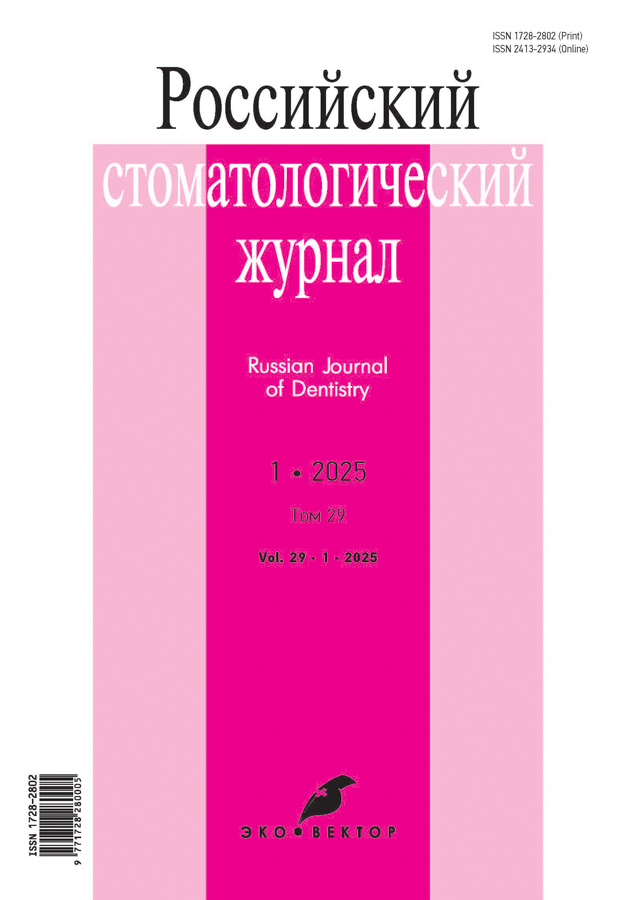Comparative efficacy and safety of chemical and physicochemical tooth whitening
- 作者: Druzhinina A.K.1, Turchenko E.F.2, Kolosovskaya A.S.3, Batirov B.M.4, Berikashvili A.E.4
-
隶属关系:
- Voronezh State Medical University
- Volgograd State Medical University
- Ural State Medical University
- V.I. Razumovsky Saratov State Medical University
- 期: 卷 29, 编号 1 (2025)
- 页面: 98-105
- 栏目: Reviews
- ##submission.dateSubmitted##: 08.10.2024
- ##submission.dateAccepted##: 02.12.2024
- ##submission.datePublished##: 01.03.2025
- URL: https://rjdentistry.com/1728-2802/article/view/636831
- DOI: https://doi.org/10.17816/dent636831
- ID: 636831
如何引用文章
详细
The review addresses different chemical and physicochemical tooth whitening methods, with a focus on their efficacy, safety, and potential side effects.
Chemical tooth whitening involves oxidizing pigments in the enamel and dentin with hydrogen peroxide and urea. Despite their high efficacy, long-term use of chemical whitening agents may cause microstructural changes in the enamel, reducing its microhardness and increasing porosity.
Physicochemical tooth whitening techniques, such as lasers and light-emitting diodes, activate low concentrations of whitening agents, decreasing the risk of enamel damage and tooth hypersensitivity. The rate and degree of tooth whitening may vary depending on the concentration of active components and the exposure time. According to the studies, higher hydrogen peroxide concentrations provide faster tooth whitening, but are more frequently associated with side effects (including tooth hypersensitivity and irritation of the gingiva and soft oral tissues).
Combination approaches have been shown to significantly reduce discomfort in patients with tooth hypersensitivity. The long-term stability of tooth whitening outcomes is actively studied, because repeated use of chemical whitening agents can promote structural changes in the enamel.
全文:
作者简介
Anastasia Druzhinina
Voronezh State Medical University
编辑信件的主要联系方式.
Email: maker.creator945@rambler.ru
ORCID iD: 0009-0008-2714-9231
俄罗斯联邦, Voronezh
Elizaveta Turchenko
Volgograd State Medical University
Email: elizaveta.turchenko@inbox.ru
ORCID iD: 0009-0000-2766-3531
俄罗斯联邦, Volgograd
Anna Kolosovskaya
Ural State Medical University
Email: pony.piebald.30@mail.ru
ORCID iD: 0009-0002-6607-5016
俄罗斯联邦, Ekaterinburg
Batir Batirov
V.I. Razumovsky Saratov State Medical University
Email: batirov.batir64@gmail.com
ORCID iD: 0009-0006-5975-3914
俄罗斯联邦, Saratov
Aleksey Berikashvili
V.I. Razumovsky Saratov State Medical University
Email: berikashvili26@mail.ru
ORCID iD: 0009-0008-0026-108X
俄罗斯联邦, Saratov
参考
- De Freitas MR, de Carvalho MM, Liporoni PCS, et al. Effectiveness and adverse effects of over-the-counter whitening products on dental tissues. Frontiers in Dental Medicine. 2021;2:687507. doi: 10.3389/fdmed.2021.687507 EDN: RELAIB
- Grand View Research [Internet]. Teeth whitening market size, share & trends analysis report by product (whitening toothpaste, whitening gels & strips, light teeth whitening device), by distribution channel, by region, and segment forecasts, 2022–2030. Available from: https://www.grandviewresearch.com/industry-analysis/teeth-whitening-market-report [cited 2024 Sep 21].
- AlShehri A, AlRefeai MH, AlZamil F, et al. Effect of over-the-counter tooth-whitening products on enamel surface roughness and microhardness. Applied Sciences. 2022;12(14):6930. doi: 10.3390/app12146930 EDN: HERNTY
- Pasquale C, De Angelis N, Barberis F, et al. Safety and effectiveness of conventional commercial products for professional tooth bleaching: comparative ex vivo study using AFM microscopy and nanoindentation. Applied Sciences. 2023;13(16):9371. doi: 10.3390/app13169371 EDN: FKNNBS
- Bogatyreva YA, Chirkova NV, Vecherkina ZV, Semynin KE. Evaluation of the level of mineralization of dental hard tissues after bleaching. Meditsinskii vestnik Bashkortostana. 2019;14(4):80–83.EDN: HOYENY
- Peng C, Park S, de Sousa FB, et al. Enhanced teeth whitening by nanofluidic transport of hydrogen peroxide into enamel with electrokinetic flows. Dental Materials. 2019;35(11):1637–1643. doi: 10.1016/j.dental.2019.08.118
- Zamudio-Santiago J, Ladera-Castañeda M, Santander-Rengifo F, et al. Effect of 16% carbamide peroxide and activated-charcoal-based whitening toothpaste on enamel surface roughness in bovine teeth: an in vitro study. Biomedicines. 2022;11(1):22. doi: 10.3390/biomedicines11010022 EDN: VKASVL
- Mokhlis GR, Matis BA, Cochran MA, Eckert GJ. A clinical evaluation of carbamide peroxide and hydrogen peroxide whitening agents during daytime use. Journal of the American Dental Association. 2000;131(9):1269–1277. doi: 10.14219/jada.archive.2000.0380
- Pascolutti M, de Oliveira D. A radical-free approach to teeth whitening. Dentistry Journal. 2021;9(12):148. doi: 10.3390/dj9120148 EDN: LIWBKW
- Kabytova MV, Chaplieva EM, Starikova IV, Piterskaya NV. Comparative analysis of effectiveness and safety of using different systems for home teeth whitening. Vestnik VoLGMU. 2020;4(76);124–126. doi: 10.19163/1994-9480-2020-4(76)-124-126 EDN: LFXSNO
- Eachempati P, Kumbargere S, Kiran Krishanappa S, et al. Home-based chemically-induced whitening (bleaching) of teeth in adults. Cochrane Database of Systematic Reviews. 2018;12(12):CD006202. doi: 10.1002/14651858.CD006202.pub2
- Hasmun N, Vettore MV, Lawson JA, et al. Determinants of children’s oral health-related quality of life following aesthetic treatment of enamel opacities. Journal of Dentistry. 2020;98:103372. doi: 10.1016/j.jdent.2020.103372 EDN: FEEZHV
- Patel P. Clinical comparative evaluation of led and diode laser on efficacy of 40% Hydrogen Peroxide on tooth whitening. Journal of Chemical Health Risks. 2023;13(6). Available from: https://jchr.ut.ac.ir/article_93656.html [cited 21.09.2024].
- Tekce AU, Yazici AR. Clinical comparison of diode laser- and LED-activated tooth bleaching: 9-month follow-up. Lasers in Medical Science. 2022;37:3237–3247. doi: 10.1007/s10103-022-03612-1 EDN: DZUASN
- Fazylova YuV, Blashkova SL, Krikun EV. Modern methods of treating dental discoloration. MNIZH. 2022;2(116). doi: 10.23670/ IRJ.2022.116.2.061 EDN: YESFRY
- Sobral-Souza DF, Gouveia THN, Condeles AL, et al. Effect of accelerated stability on the physical, chemical, and mechanical properties of experimental bleaching gels containing different bioadhesive polymers. Clinical Oral Investigations. 2022;26(3):3261–3271. doi: 10.1007/s00784-021-04308-6 EDN: WUQNQU
- Melo M, Fioresta R, Sanz JL, et al. Effect of highly concentrated bleaching gels on enamel microhardness and superficial morphology, and the recovery action of four remineralizing agents. BMC Oral Health. 2022;22(1):645. doi: 10.1186/s12903-022-02693-2 EDN: QHBBYM
- Rezende M. Tooth sensitivity after dental bleaching with a desensitizer-containing and a desensitizer-free bleaching gel: a systematic review and meta-analysis. Operative Dentistry. 2019;44(2):E58–E74. doi: 10.2341/18-194-LIT
- Rachmad PN, Rachmadani AP, Nur Rachman RP, et al. Impact in oral cavity due to the use of hydrogen peroxide in dental treatment. Pediatric Dental Journal. 2020;4(5). doi: 10.32474/IPDOAJ.2020.04.000199
- Goldberg M, Grootveld M, Lynch E. Undesirable and adverse effects of tooth-whitening products: a review. Clinical Oral Investigations. 2010;14(1):1–10. doi: 10.1007/s00784-009-0302-4 EDN: ECHGOD
补充文件






